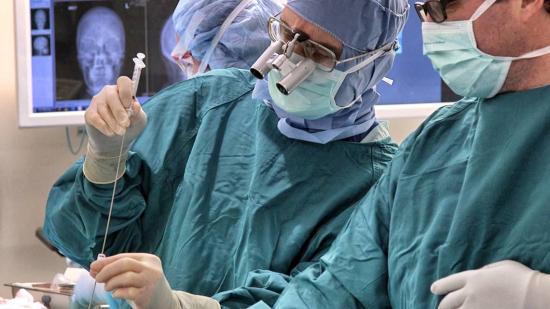Can polio, a killer virus from the past, treat cancer in the present? Duke is optimistic.

The virus that causes polio is like an overeager guard dog that ravages nerve cells and paralyzes people, as it did to former President Franklin Delano Roosevelt.
But what if we could train that dog to attack only invaders like cancer cells and leave friendly brain cells alone? That’s exactly what Duke researchers did.
In a study published last week in the New England Journal of Medicine, doctors modified poliovirus and inserted it into brain tumors. Historically, only 4 percent of brain tumor patients survive at least three years after diagnosis, but 21 percent of the study's patients lived that long. Researchers hope this method could also treat other cancers.
“Poliovirus had evolved as one of the most potent cell-killing viruses there is,” study author Dr. Darell Bigner of Duke said. “[The scientist who created this thought that] the cell-killing ability of nerve cells could be redirected to kill the brain tumor cell. … This virus is capable of working on virtually all solid tumors.”
What is recurrent glioblastoma?
Glioblastoma, which is what Sen. John McCain has, is the most aggressive type of brain cancer. Doctors grade brain tumors on a scale of one to four based on how fast they grow. Glioblastomas are Grade IV. The National Brain Tumor Society, which helped fund the study, estimates about 79,000 people will be diagnosed with a brain tumor in 2018.
Three years after graduating from college, Michael Niewinski of Boca Raton, Fla., had a grand mal seizure. He was diagnosed in 2011 with a Grade II brain tumor. After the standard approach of surgery, radiation therapy and chemotherapy, the tumor progressed to Grade III in 2015. Last year, he was diagnosed with a Grade IV glioblastoma and joined the next phase of the study.
“It was bittersweet when they told me I had the Grade IV,” Niewsinski said. “I was like, 'Oh, no, this is bad,' but that’s the only reason I became eligible for the trial, so it’s like a blessing and a curse.”
After the tumor recurs, or comes back, patients don’t have many treatment options. The Duke study recruited 61 patients with recurrent glioblastoma to try the poliovirus approach.
“Virtually every single [glioblastoma] recurs,” Bigner said. “Those patients all die within a year or less. That’s why these long-term survivals are so important in telling us this [study] is different.”
How poliovirus destroys brain tumors
The researchers cut out the poliovirus genes that held instructions on how to spread through the brain and replaced them with the same genes from the common cold virus. This trained the guard dog to attack where they pointed it, instead of running wild through all the cells. Then they drilled a small hole in patients' skulls and put the virus into the tumors, using CT scans to guide the surgery.
“It redirected the killing ability,” Bigner said. “It lost the ability to kill nerve cells but retained the ability to kill cancer cells.”
Our immune systems fight off invaders, but our white blood cells don’t get the memo with cancer cells. Cancer cells form when our normal cells duplicate and reproduce without dying off. Sometimes cancer cells hide from our immune system by pretending to be regular cells.
The poliovirus technique turbo-boosts the immune system to attack those masquerading cancer cells.
Because we are vaccinated against polio as kids, when the poliovirus starts killing tumor cells, our immune system jumps in and kills the virus.
But our attack dog has already done what it actually meant to do — infect certain helper white blood cells and trigger inflammation, which happens when blood cells rush to the scene.
“The tumor cell contents spill into this sea of inflammation, and the immune system recognizes the mutated cells and it sets up an immune reaction,” Bigner said. “The infected cells help turn on the killer white blood cells. The inflammatory reaction is what sensitizes the killer white blood cells, which can travel anywhere in the brain and kill tumor cells.”
After his poliovirus injection, Niewinski’s inflammation response fought off his tumor.
“I’m seeing exactly what they said we would see,” Niewinski said. “For a couple months, you see this huge immune reaction, and then it reached the peak of all that swelling, and then you see it go down. I’m at that point now.”
What’s next in the fight against brain cancer
For the 38 patients whose tumors grew even after the poliovirus injection, researchers offered an older chemotherapy drug. To enter the clinical trial, the patients’ tumors already had failed to respond to standard chemotherapy. So they didn’t want to try the usual drugs again. Surprisingly, combined with the poliovirus treatment, the older drug disintegrated many of the tumors.
Researchers use Phase I trials like this one to figure out the best dose of a drug to be useful without too many side effects. In Phase II of the trial, which is starting in a few weeks at three other sites across the nation, the researchers will compare patient outcomes of using only poliovirus versus following the virus with the chemotherapy drug.
“We’re excited about the early promising results from the Duke trial," said Dr. Elizabeth Gerstner of Massachusetts General Hospital Cancer Center, which will take part in the Phase II trial. "It’s important to confirm those results and address some of the questions of how efficacious this is.”
Since his poliovirus injection in August 2017, Niewinski, one of the first patients in the Phase II study, has experienced no side effects. In October, he followed up with the chemotherapy drug and has noticed a difference in his bimonthly MRI scans. In particular, he can see his ventricles, which are highways that carry protective fluid through the brain.
“I know the tumor is getting smaller because I’m beginning to see parts of my brain [on the MRI scans] that I didn’t know were there before,” Niewsinski said. “I have a ventricle close by my tumor that looks like a path going down my brain. Between two of my scans, that ventricle opened up, like something was pinching it before.”
Phase III studies include many patients at different institutions. Phase III is the last stop before researchers seek approval from the Food and Drug Administration.
When a treatment gets “breakthrough” status, as this poliovirus approach did, it spends less time on clinical trials and gets approved faster. The median development time for all FDA drugs is eight years, while “breakthrough” status drugs are approved in closer to five years, according to a 2017 study in the Journal of the American Medical Association.
If the Phase III trials are successful, the poliovirus treatment may be available to patients in the next three to five years, estimated Dr. Evanthia Galanis of the Mayo Clinic in Minnesota, which is not involved in the study.
“Glioblastoma is a complex and challenging disease, and a comprehensive approach to new treatment development includes multiple angles,” Galanis wrote via e-mail. “We need more than one clinical trial to solve this difficult problem.”
The Mayo Clinic is also developing virus and immune-system-related approaches to treat glioblastoma, Galanis wrote. Another Phase I trial is in the works to add immune system compounds that have worked on skin cancer, called checkpoint inhibitors, to the poliovirus injection.
“Checkpoint inhibitors by themselves don’t do anything to glioblastoma,” Bigner said. “But the [skin cancer] tumors that respond are ones with white blood cells in them, called ‘hot tumors.’ Glioblastoma is almost always cold. The virus converts cold tumors into hot ones.”
Implications for other types of cancer
Soon Duke will start Phase I of applying the poliovirus to breast cancer and skin cancer. To work, the poliovirus must be inserted directly into the tumor cells, which isn’t always possible with different types of cancer. But Bigner is hopeful that this technique can be applied to many other cancers.
“In animal models and in the lab, we’ve shown the virus works on prostate cancer, lung cancer, breast cancer, pancreatic cancer, stomach cancer,” Bigner said. “We haven’t found anything that it doesn’t work with in the laboratory.”
If the breast cancer and skin cancer trials are successful, Bigner hopes to expand to other types of tumors. Gerstner, from Massachusetts General Hospital, said we should be careful about jumping to conclusions about the effectiveness of polio to fight other cancers.
“The challenge is that humans are not animal models or petri dishes,” said Gerstner. “You do have to start somewhere, with petri dishes, and then you move to animal models. It’s hard looking at pre-clinical data (to tell) how successful it will be in humans.”
When it comes to glioblastomas, which are only one type of brain cancer, we should be “cautiously optimistic,” said David Arons, CEO of the National Brain Tumor Society. The society website says that 75 of 78 brain tumor trial drugs have failed between 1998 and 2014.
“We’ve made great advances on brain tumors in the lab and gone on to see failures in clinical trial after clinical trial,” Arons said. “Here we are again and we’re very optimistic, but there are these cautionary tales of other brain tumor approaches that haven’t worked even after spectacular Phase I data.
“We’re of course very hopeful for each patient in the trial, hoping that this approach saves their lives. We know that patients are ultimately a statistic of one. But we’re also out there to cure a population.”
Niewinski, the Phase II patient who has been battling brain cancer since 2011, is grateful to be in the study and amazed by the solution.
“It’s nuts how genius it is,” Niewinski said. “Polio was killing people in the 1920s and '30s and '40s, and now it’s helping me get cancer out of my brain. It’s pretty nuts.”

























